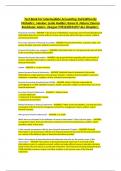Examen
Intermediate Accounting 2nd Edition By Michelle L. Hanlon; Leslie Hodder; Karen K. Nelson; Darren Roulstone; Amie L. Dragoo 9781618533357 ALL Chapters .
- Grado
- Institución
- Book
Intermediate Accounting 2nd Edition By Michelle L. Hanlon; Leslie Hodder; Karen K. Nelson; Darren Roulstone; Amie L. Dragoo 9781618533357 ALL Chapters .
[Mostrar más]




